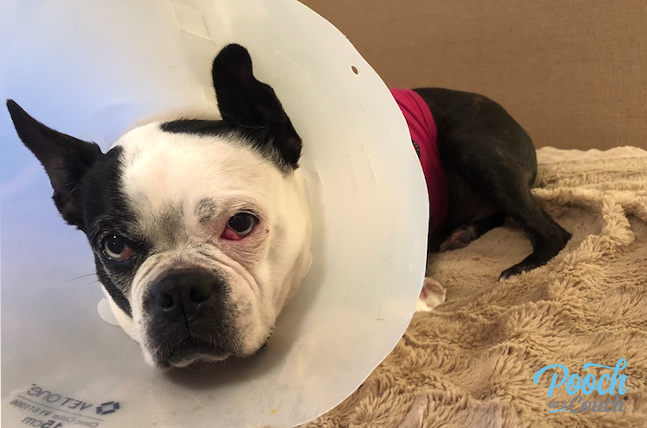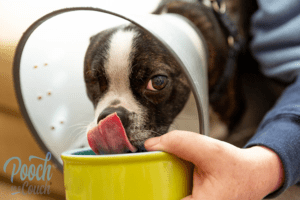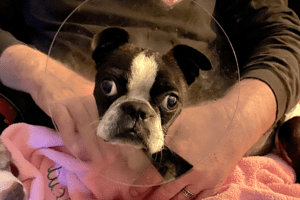As a lifetime Boston terrier owner and a foster parent for a lot of foster dogs, I’m familiar with the breed and their risk for developing eye problems. Not only do we see many rescued Boston terriers with cataracts, glaucoma, or cherry eye, we see a lot of corneal ulcers in dogs.
Corneal ulcers are not limited to the Boston terrier breed, any dog (or cat, or human!) can develop a corneal ulcer. Corneal ulcers may develop as a result of another eye condition like dry eye or entropion, or they may occur as a result of trauma, like bumping into a pointy leaf or in Sassy’s case, walking through seagrass.
I am not a veterinarian nor an animal behaviorist. I present my understanding of health or behavior issues based on personal experience and research I’ve done. If you have a dog with a health or behavioral issue, seek professional guidance. I hope you find my post useful.
Sassy Blue Has A Corneal Ulcer – And A Cherry Eye
I’ve been fostering Sassy Blue for several months and during that time, she’s had a mild to moderate cherry eye, depending upon the day or the weather, or the environmental allergies blowing in the wind.
Odd, because usually, in my experience, cherry eye doesn’t disappear and then reappear, again and again.
Sassy’s does.
Cherry eye is a non-life-threatening issue in dogs, however, left untreated, cherry eye can cause chronic eye problems such as decreased tear production and chronic eye tissue inflammation. Decreased tear production is a leading cause of corneal ulcers in dogs.
Sassy’s cherry eye hasn’t yet been repaired because we’ve been dealing with repeat surgeries to remove growths on her mammary chain. Bottom line: possible breast cancer trumps cherry eye every time. We’ve delayed eye surgery because she’s needed breast surgery first.
(update: Sassy’s cherry eye has been repaired)
First Hint That Sassy Might Have a Corneal Ulcer
Over the weekend, Sassy’s cherry eye eye (the left eye) didn’t look like it usually looks: Her eye was really watery, red, and the cherry eye tissue was protruding larger than I’d ever seen it. She was also wimpering and pawing at her eye.
Do not dismiss a dog that is pawing at their eye or squinting their eye closed. If they do that, something is wrong.
I took a good hard look at her eye, best I could. Sassy has developed some pretty strong eyelid muscles, and she can clamp that eye shut, making it hard to open it and get a closer look!
Corneal Ulcers Are Painful
Many corneal scratches and ulcers are the result of trauma, and many of them are located on the front of the eye, like in the center. I looked and I didn’t see anything, but that doesn’t mean there isn’t anything wrong! Corneal scratches are usually invisible to the naked eye, but they are quite painful, which is why a dog squints, blinks excessively, paws at their face, whimpers, etc.
Since I couldn’t see evidence of an ulcer, I wondered if there might be a grain of sand or some debris in her eye, possibly trapped between her eye and that wad of third eyelid tissue protruding out of the inner corner of her eye.
I keep an unopened, in-date bottle of eye wash in my first aid kit just for situations like this. I cracked the seal and gave the eye a good but gentle irrigation.
She stopped pawing at her eye. Maybe it was debris in her eye, and I’d washed it out.
With Corneal Ulcers in Dogs, Time Is Critical
But her eye didn’t really look better, and the next morning, she had the tiniest amount of yellowish-green discharge.
Also, she wasn’t really squinting her eye like dogs do when they have a corneal scratch. Injured eyes are painful and is pretty sensitive to light. Dogs close the eye because it feels better when they do.
So, I thought she was developing conjunctivitis, an inflammation of eye tissue, and made plans to get her to the vet for an evaluation and hopefully some meds.
We took (actually, I pushed for) the first available appointment. Always tell the vet clinic when you are bringing in a dog with a potential eye issue – dog eyes can deteriorate pretty quickly, and most veterinarians consider eye injuries a veterinary emergency.
This is NOT a time to take a wait-and-see approach.
If you suspect an eye injury in your dog, don’t walk,
RUN to your vet clinic.
Evelyn Bibb, Alabama Boston Terrier Rescue
Evaluating Corneal Ulcers In Dogs
Sassy’s vet took a look and quickly began her eye assessment: She looked at the lens, (not luxated) assessed tear production using a Schirmer Tear Test (tear production was healthy) and finished with an fluorescein eye stain test to pick up early corneal changes.
“Yep. This eye is picking up a lot of stain.”
She looked further and saw changes to the eye in the upper outer corner of the eyeball, and she suspected granulation tissue. Sassy certainly wasn’t making the eye exam easy.
“Are you ready to lose some sleep?” Dr. Jen said. I took a deep breath. It’s been a while since I’ve had to lose sleep caring for a foster dog.
She proceeded to describe next steps: She’d sedate Sassy, remove the granulation tissue, and then start Sassy on two eye drops, each to be given every two hours, around the clock.
It’s an aggressive treatment plan. Many would say it’s overkill, but we find that aggressive treatment facilitates faster healing, improved comfort, prevents middle-of-the-night crises, and can help avoid specialty care.
Corneal Ulcers in Dogs 101
The cornea is the clear, shiny membrane that covers the front of the eyeball. It’s made up of several layers of tissue: the epithelium, the stroma, and the Decemet’s membrane. All of these layers are made up of specialized cells.
When you’ve helped a dog recover from an eye injury, you get a keen awareness of the healthy eye’s potential to heal itself beautifully, with medical support. That said, the deeper the injury, the more support the eye needs. An injury can go from a superficial corneal scratch to a corneal rupture in a very short amount of time.
In other words, if you suspect your dog has an eye injury, pick up the phone and call the veterinary clinic and schedule an appointment.
How Do I Know If My Dog Has A Corneal Ulcer?
How do you know if your dog has a corneal ulcer? Depends. I certainly didn’t know Sassy had a corneal ulcer until the vet told me.
Corneal abrasions or superficial scratches to the cornea probably can’t be seen by your naked eye. If an ulcer develops, you may be able to see it when they get deep into the stroma, but by that time, you REALLY need to get to the vet! My advice? Catch it before then by looking for key symptoms and behaviors.
Corneal abrasions are very painful, and the eye also becomes very sensitive to light. A dog may keep the affected eye closed, especially when in bright light, they may paw at or rub the eye, and the eye may be watery or have clear or colored discharge.
So, listen to your dog, and pay attention to those behaviors. If your dog is squinting, pawing/rubbing the eye, producing eye discharge – get to the vet, pronto!!
Eye injuries can progress in a matter of hours – ulcers can perforate, causing the eye to rupture and the eyeball to fail.
The Only Way To Easily Diagnose Corneal Ulcers
Every single time I take a dog to the vet for an eye issue, they always, always, always use a special stain called a fluorescein test. This stain is a spooky green color, and as the name suggests, the stain fluoresces under a special light.
The stain is applied to the front of the eyeball and it will stick to areas of the eyeball that are ulcerated. Larger ulcerations will appear easily, smaller ones show up with a special light.
Can’t I Skip The Flourescein Test And Use Eye Drops I Already Have From Another Dog’s Eye Infection?
Oooooooh!!! Goodness NO!
While the treatment for corneal abrasion and corneal ulcers in dogs is to use an ophthalmic antibiotic drop, some ophthalmic drops have combination medications, and some of those medications may have adverse reactions and make the corneal ulcer progress and cause the eyeball to ulcerate and fail.
Moreover, having the fluorescein stain test results can open up options for medications for your dog’s eye. Your vet may be able to prescribe other eye drops for the eye if a corneal ulcer is ruled out.
An eye is no place for DIY vet care.
Treatment For Corneal Ulcers in Dogs
Ophthalmic Antibiotics
For simple ulcers or abrasions, your veterinarian will likely prescribe either an antibiotic drop or an antibiotic ointment (or both). These medications work by keeping bacteria and infection at bay so that the eye can work to heal itself.
Medications or drops are given several times a day, and usually the vet wants to see the dog for recheck in 3-4 days to assess progress. If the dog’s eye isn’t healing satisfactorily, the vet can change treatment plans or initiate a referral to an ophthalmologist for further assessment and treatment.
Be prepared to lose a little sleep if your directions include getting up in the middle of the night to administer drops. I had to get up every two hours to give Sassy her eye medications.
Corneal Ulcers and Pain Management
As mentioned, corneal ulcers in dogs are very painful and we do want to provide the dog relief from discomfort.
Many vets and ophthalmologists use Atropine drops for pain management. Because of how Atropine works, I find vets are using it less and less with the treatment of corneal ulcers: It dilates the eye, causes side effects such as nausea, thirst, dry mouth, and can have neurologic side effects as well.
In my non-veterinary-degree experience, a better way to treat pain in a dog with a corneal ulcer is to use oral pain medications. Your vet may prescribe a pain medication with anti-inflammatory properties or one without.
If your vet is prescribing Atropine drops for pain management during the treatment of corneal ulcers, question that decision and ask for oral pain medications instead.
How To Care For A Dog With A Corneal Ulcer
Caring for a dog with a corneal ulcer is pretty straight forward: follow the treatment plan!
- Follow the schedule. If the instructions say administer drops every 4 hours, do it. Set your alarm for the middle of the night and get up. Work all day? Talk with your veterinarian about options, or have a pet sitter or dog walker come over and administer medications. This is a foster dog? Talk with your rescue administration. I guarantee they are willing to pay for a pet sitter to avoid a potential emergency vet bill or expense for specialty eye care. They should be.
- Clarify the order of medication administration. If you have to give more than one drop or ointment, make sure you ask if there is any particular order or time gap between the different medications being administered.
Sassy had two medications, both in drop form. For these medications, it doesn’t matter what order they are in, but I have to wait 5 minutes in between drops.
In the case of ointments and drops, usually, the veterinarian or ophthalmologist is going to instruct that the drop goes in first, wait, then follow by the ointment. This is because the ointment can create a barrier, preventing the drop from reaching eye tissue. - Monitor play. This is especially important if the corneal ulcer is deep or at risk of perforating. A simple bump can mean a breach of the stroma layer of the cornea, causing the eye to rupture. So, don’t let your dog engage in rough play while the eye is healing. Gentle walks can be OK, but remember, the injured eye is really sensitive to light, so be mindful.
- Use an Elizabethan collar!! In the case of eyes, the standard, plastic, vet-issue model is the best option. I know what you are thinking (uncomfortable, frustrating for the dog, scary for the dog, etc) however – here is why: Dogs instinctively try to rub an eye that is painful. Soft e-collars collapse and make it really easy for a dog to rub their eye. Donut collars provide no protection to the eye whatsoever. If a dog is allowed to rub their eye, they could cause the eye further injury or worse, the eye could rupture and have to be removed.
How to help your dog feel comfortable wearing an elizabethan collar
Here is a link to a newer product on the market that for the first time ever, may provide a reasonable alternative to the plastic cone when we need to protect our dog’s face and eyes. It’s called the Optivisor. I have not used it, but if you have, I’m really interested in hearing from you! Share your experiences with me.
Expect Frequent Rechecks of the Corneal Ulcer
I expect my veterinarians to ask for a recheck of a corneal ulcer in 3 days. Indeed, Sassy’s recheck is in three days. So, be prepared to rearrange your schedule to get your pup back into the vet’s office for a recheck.
Here is why you do not want to skip the recheck: Your dog may act like they feel better, and the eye may even look better, but it may be getting worse despite your good care. Let the veterinarian’s eye assessment be the guiding light – not your layman’s opinion.
Don’t skip the recheck!
Further Treatments for Corneal Ulcers in Dogs
Sometimes, despite good care, a corneal ulcer will not heal or will have more difficulty healing without a surgical intervention. In rescue, we have a tendency to take eyes out before we’ve exhausted reasonable interventions to save the eye. I’m not passing judgement, but simply outlining surgical options available when medication treatment alone is not working.
- Debride the ulcer of dead corneal tissue (under sedation). Sassy had this procedure done. When bad tissue is removed, the wound is stimulated to begin the healing process again.
- Grid Keratectomy or scraping the cornea in a grid pattern. This sound awful! But it absolutely promotes healing with successful healing occurring in most patients in 10-14 days.
- Corneal Graft is when healthy tissue is sutured over the corneal ulcer. This technique is used when the eye is not responding to treatment, or the eye is at high risk of rupture and loss. This procedure is expensive, invasive, and requires full anesthesia but the success rate is remarkable.
In summary:
- If your dog/foster dog is acting like their eye hurts (squinting, red/watery, pawing at it) GO TO THE VET, a.s.a.p.
- If your dog is diagnosed with a corneal abrasion or ulcer, FOLLOW THE CARE PLAN to the letter.
- Even if it means losing sleep and paying for pet care assistance.
- Protect the eye from further injury by monitoring play and using a plastic Elizabethan collar.
- Veterinary ophthalmology has many treatments to help save a dog’s eye.
Have you ever had to care for a corneal ulcer in a dog? What were your challenges? What helped you help your dog? Share your story in comments!

Read More About Corneal Ulcers in Dogs
Corneal Ulcers in Dogs -Ethos Veterinary Health
Several Treatment Options For Corneal Ulcers In Dogs




